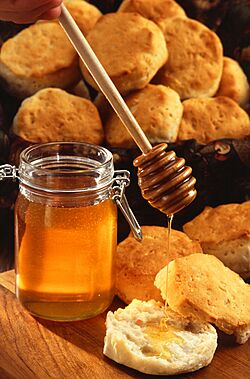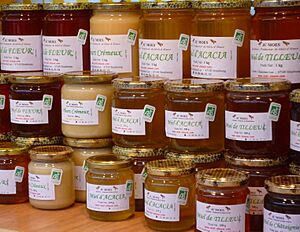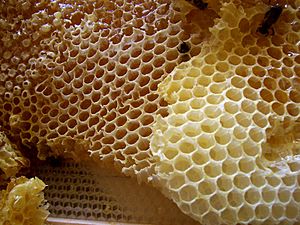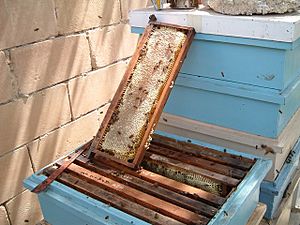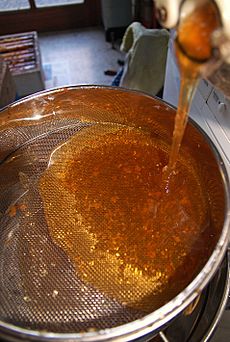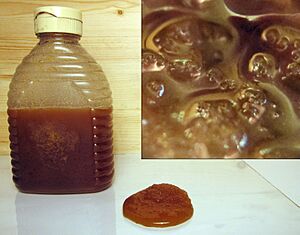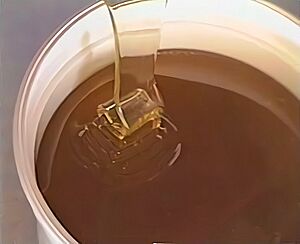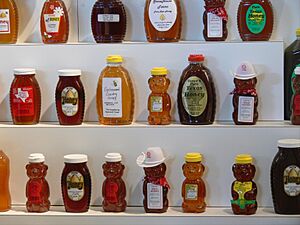Honey facts for kids
Honey is a sweet, thick liquid made by different kinds of bees, especially honey bees. Bees create and store honey to feed their colonies. They make honey by collecting sugary liquids from plants, mostly nectar from flowers, or from other insects, like the sweet "honeydew" left by aphids.
This sweet liquid becomes honey through a special process. Bees first gather the liquid. Then, they refine it inside their bodies by bringing it up and adding special chemicals called enzymes. They also store it in their hives, where water slowly evaporates. This makes the honey thick and concentrated with sugars.
Honey bees store their honey in a structure called a honeycomb. This honeycomb is made of wax and has many tiny, six-sided cells. The bees put the honey into these cells for storage. Other types of bees, like stingless bees, store honey in different kinds of wax and resin pots.
People collect honey from wild bee nests or from special hives kept by humans. Honey from honey bees is the most common kind you'll find. Taking care of bees to produce honey is called beekeeping or apiculture. When people care for stingless bees, it's often called meliponiculture.
Honey tastes sweet because it has a lot of natural sugars like fructose and glucose. It's about as sweet as regular table sugar. Just one tablespoon of honey gives you about 43 calories of energy. Honey is great for baking and adds a unique flavor as a sweetener. Most tiny living things (microorganisms) can't grow in honey. This means sealed honey usually doesn't spoil. In fact, honey found in ancient tombs has still been good to eat thousands of years later!
People have been using and making honey for a very long time, even before history was written down. Cave paintings in Spain, over 8,000 years old, show humans collecting honey. In ancient times, Mayans in the New World also practiced large-scale beekeeping with stingless bees.
How Bees Make Honey
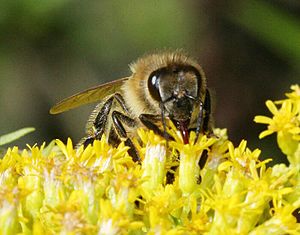
Honey Bee Production Process
Bees make honey from nectar or honeydew. They need the sugars in honey for energy, especially for flying when they search for food. Honey also feeds their young (larvae). Bees store honey so they have food during winter or when flowers are scarce. When a bee collects nectar, it uses some for its own energy. Most of the nectar, however, is meant for making honey to store.
A foraging bee leaves the hive to find sugary nectar or honeydew. Nectar from flowers usually has a lot of water (70-80%). Honeydew is also quite watery. The bee sucks up these liquids with its proboscis (a straw-like mouthpart). The liquid goes into a special "honey stomach" or "honey crop," which is different from its regular stomach.
Inside the honey stomach, the bee's saliva adds special enzymes. These enzymes start breaking down complex sugars into simpler ones like glucose and fructose. This process also makes the liquid a little more watery and acidic.
When the foraging bee's honey stomach is full, it returns to the hive. There, it passes the nectar to other hive bees. These hive bees then repeatedly bring the nectar up and form bubbles with their mouthparts. This bubbling helps to mix in more enzymes and, importantly, makes water evaporate into the warm air of the hive.
Hive bees work together in groups to process the honey. They pass the liquid from bee to bee, continuing the bubbling and evaporation. This can take up to 20 minutes until the honey is ready for storage. The new honey is then placed into the wax cells of the honeycomb. At this point, the honey still has a lot of water, sometimes up to 70%. If left like this, tiny yeast spores could grow and spoil the honey.
To prevent spoilage, bees use a special ability: they can create their own body heat. Bees keep their hives at a steady warm temperature, usually around 35°C (95°F) in the honey storage areas. They also use their wings to fan air across the wet honey. This fanning helps more water evaporate, making the honey thicker and drawing heat away from the hive.
This evaporation continues until the honey reaches its final water content, which is usually between 15.5% and 18%. With so little water and so much sugar, it's very hard for any microorganisms to grow. This stops the honey from fermenting. Once the honey is ready, the bees seal the cells with wax caps. This protects the honey from dirt and stops any more water from evaporating. As long as its water content stays low, honey can last almost forever, both in the hive and after people collect it.
Honey from Other Insects
Honey bees aren't the only insects that make honey. All non-parasitic bumblebees and stingless bees also produce honey. Some types of wasps in South and Central America, like Brachygastra lecheguana, also feed on nectar and make honey. Other wasps, such as Polistes versicolor, eat honey too. They switch between eating pollen (for protein) and honey (for energy) during their lives.
How People Help Bees (Beekeeping)
Humans have learned to work with several types of honey bees. They take advantage of a natural process called "swarming." Swarming happens when a bee colony gets too big for its hive. The old queen bee lays eggs for new queens, then takes about half the colony to find a new home. Before they find a new spot, the swarm often gathers in a cluster, like on a tree branch. These swarms are usually calm and easy for people to move.
When beekeepers provide a good new home, like a special Langstroth hive, the swarm will happily start a new colony there. These bees are then cared for by people who practice beekeeping (apiculture) or stingless bee keeping (meliponiculture). Beekeepers encourage the bees to collect nectar, often in places like fruit orchards where bees are important for pollinating plants. People then harvest the honey, pollen, wax, and other useful things the bees produce.
Bees are considered "semi-domesticated" because even in large beekeeping farms, swarms can still leave and start successful wild colonies. A big part of commercial beekeeping is encouraging hives to stay and produce more honey in their current location. Beekeepers do this by adding more space to the hive with "honey supers," which are empty boxes placed on top. This gives the bees more room to build honeycomb instead of dividing their colony and swarming away.
Collecting and Storing Honey
Honey Collection
Honey is collected from wild bee colonies or from domesticated beehives. On average, one hive can produce about 30 kilograms (65 pounds) of honey each year. Sometimes, people find wild bee nests by following a honeyguide bird.
To safely collect honey, beekeepers often use a bee smoker. The smoke makes the bees think there might be a fire, so they eat honey to save their food supply. This makes them less aggressive and also hides the chemical signals (pheromones) they use to communicate. Beekeepers then remove the honeycomb from the hive. The honey can be taken out by crushing the comb or by using a honey extractor machine. After extraction, the honey is usually filtered to remove any bits of beeswax or other debris.
In the past, before special removable frames were invented, bee colonies were often destroyed to get the honey. The beekeeper would take all the honey and start a new colony the next spring. Now, with modern beekeeping, most beekeepers make sure their bees have enough honey to last through the winter. They either leave some honey in the hive or give the bees sugar water or solid sugar as food. The amount of food needed depends on the type of bees and how long and cold the winter is. Many animals are also attracted to honey, both in the wild and in human-kept hives.
Honey Preservation
Honey is great for long-term storage because of what it's made of and its chemical properties. It can be eaten easily even after being stored for a very long time. The secret to its long life is keeping it away from moisture. When honey is properly sealed, its high sugar content stops anything from growing in it. But if it's left open to moist air, honey will absorb water. This can dilute it enough for fermentation to start.
Honey's long shelf life is also partly due to an enzyme found in bee stomachs. Bees mix this enzyme, called glucose oxidase, with the nectar they collect. This creates two byproducts: gluconic acid and hydrogen peroxide. These help make honey acidic and stop bacteria from growing.
Checking Honey Quality
Sometimes, other sugars or syrups are added to honey. This might be done to change its flavor or thickness, make it cheaper, or stop it from crystallizing too quickly. People have been mixing things with honey since ancient times. For example, honey was sometimes blended with plant syrups like maple or sorghum. In modern times, clear corn syrup became a common addition. It can be very hard to tell the difference between pure honey and honey mixed with these syrups.
According to international food standards, any product labeled "honey" must be pure. However, rules can vary between countries. Experts use special tests, like checking the carbon isotopic signature, to detect if corn syrup or cane sugar has been added. These tests compare the natural chemical makeup of honey to that of other sugars. This helps ensure that the honey you buy is truly pure.
Global Honey Production
| 463,500 | |
| 114,886 | |
| 84,591 | |
| 80,389 | |
| 73,395 | |
| 62,855 | |
| World | 1,893,805 |
| Source: FAOSTAT of the United Nations | |
In 2023, the world produced about 1.9 million tons of honey. China was the biggest producer, making 24% of the total. Other major producers included Turkey, Ethiopia, and Iran.
How We Use Honey Today
Honey as Food
Honey is a popular food used in many ways. People use it in cooking, baking, and desserts. It's a tasty spread on bread and can be added to drinks like tea. It's also used as a sweetener in some store-bought beverages.
Because honey provides a lot of energy, it has been an important food for many cultures, especially those who hunt and gather food in warm places. Some groups, like the Hadza people, even consider honey their favorite food. In Africa, some honey hunters work with special "honeyguide" birds. These birds lead humans to wild beehives, and in return, they get to eat some of the wax and larvae.
Honey in Drinks
One of the oldest fermented drinks in the world is mead, also known as "honey wine." It dates back about 9,000 years! Mead is made by adding yeast to a mixture of honey and water, then letting it ferment for weeks or months. Today, a common yeast used is Saccharomyces cerevisiae.
There are many kinds of mead. Some, called metheglin, have spices or herbs. Melomel includes fruit juices. Honey is also used to make a type of beer called "braggot."
What Makes Honey Special
Honey has many interesting physical properties. These depend on how much water it has, the types of flowers the bees visited, and the temperature. Fresh honey is a "supersaturated" liquid. This means it has more sugar dissolved in it than water can normally hold at room temperature. Because of this, the glucose in honey often turns into tiny solid crystals over time. This makes the honey become thick and grainy, like a semi-solid mixture of sugar crystals in a liquid of fructose and other ingredients.
Honey is quite dense, usually weighing between 1.38 and 1.45 kilograms per liter at 20°C.
Why Honey Changes Texture
The melting point of crystallized honey is between 40°C and 50°C (104°F and 122°F). Below this temperature, honey can stay liquid for a while, but it often starts to crystallize on its own. Honeys with a lot of glucose, like brassica honey, crystallize very quickly. Honeys with less glucose, like tupelo honey, might not crystallize at all. Some honeys form a few large crystals, while others form many small ones.
The amount of water in honey also affects crystallization; more water means less crystallization. Temperature plays a role too. Crystals grow fastest between 13°C and 17°C (55°F and 63°F). If you stir or shake honey, it can also make crystals form more easily. However, if honey is kept below 5°C (41°F), it usually won't crystallize, keeping its original texture and flavor.
At very cold temperatures, honey doesn't freeze solid like water. Instead, it becomes very thick and slow-moving. At -20°C (-4°F), honey might seem solid, but it still flows, just very slowly. Below about -42°C to -51°C (-44°F to -60°F), honey turns into a solid, glass-like state.
How Thick is Honey?
The thickness, or viscosity, of honey changes a lot with temperature and water content. The more water honey has, the more easily it flows. At 25°C (77°F), honey with 14% water is much thicker than honey with 20% water. As honey gets colder, it becomes much thicker. For example, honey with 16% water is quite thin at 70°C (158°F) but becomes very thick at 14°C (57°F). Even though honey is thick, it has a low surface tension, which is why it spreads easily and feels sticky.
Most honeys are like "Newtonian liquids," meaning they flow predictably. But a few types, like heather or mānuka honey, are "non-Newtonian." These honeys become gel-like when still, but turn liquid when stirred.
Why Honey Lasts So Long
Honey can absorb moisture from the air, a process called hygroscopy. The amount of water it absorbs depends on how humid the air is. Because honey contains yeast, this ability to absorb water means it must be stored in sealed containers. If the water content rises above 25%, the yeast can start to grow and cause the honey to ferment.
Fermentation often happens after honey crystallizes. This is because when glucose forms crystals, the remaining liquid part of the honey has a higher percentage of water, which allows yeast to grow. To prevent this, honey that will be stored for a long time is often pasteurized (heated to over 70°C or 158°F) to kill any yeast.
Honey's Color and Flavor
Honey usually ranges from pale yellow to dark brown, but its color can change depending on the flowers the bees visited. For example, bees that collect nectar from Kudzu flowers can produce honey that is red or even purple!
The flavor and smell of honey come from over 100 different natural compounds called "volatile organic compounds" (VOCs). These compounds are mostly from the nectar of the flowers. They give honey its unique aromas, like "flowery," "citrus," or "sweet." The type of flowers, the soil, and even the region where the flowers grow can affect these flavors and smells. These compounds can also change over time or with heat, which is why honey's taste and aroma can vary.
Types of Honey
Honey is grouped by where its nectar comes from (what flowers the bees visited) and how it's packaged or processed. In some places, like the US, honey is also graded by its color and how clear it is.
Honey by Plant Source
Honey is usually classified by the type of flower nectar the bees used to make it.
Single-Flower Honey (Monofloral)
Monofloral honey is made mostly from the nectar of one type of flower. These honeys have special flavors and colors because of their main flower source. To make single-flower honey, beekeepers place their hives where bees can mostly access just one kind of flower. Examples include clover, orange blossom, tupelo, lavender, and sunflower honey.
Mixed-Flower Honey (Polyfloral)
Polyfloral honey, also known as wildflower honey, comes from the nectar of many different types of flowers. Its taste can change from year to year, and its smell and flavor can be stronger or milder depending on which flowers are blooming.
Honeydew Honey
Honeydew honey is made when bees collect sweet secretions directly from trees like pine or oak, or from the "honeydew" left by plant-sap-sucking insects like aphids. This honey has a stronger, less sweet flavor than honey made from flower nectar. In Greece, pine honey (a type of honeydew honey) makes up a large part of their honey production.
Honey by How It's Packaged and Processed
Honey is usually sold as a liquid, but it comes in other forms and can be processed in different ways.
- Crystallized honey happens when some of the glucose sugar naturally forms solid crystals. It's also called "granulated" or "candied" honey. You can turn crystallized honey back into liquid by gently warming it. Crystallization doesn't mean the honey has gone bad!
- Pasteurized honey has been heated to high temperatures (like 72°C or 161°F or more). This heating kills yeast cells and helps delay crystallization. However, too much heat can change the honey's taste, smell, and color.
- Raw honey is honey as it comes from the beehive, or after being simply extracted, settled, or strained. It hasn't been heated much. Raw honey often contains some pollen and tiny bits of wax.
- Strained honey has been passed through a mesh to remove larger particles like wax, but it still keeps pollen, minerals, and enzymes.
- Filtered honey has been filtered very finely to remove almost all tiny particles, pollen, and air bubbles. This usually involves heating the honey to make it flow through the filter more easily. Filtered honey is very clear and takes longer to crystallize, which is why supermarkets often prefer it.
- Creamed honey (also called whipped or set honey) is processed to control crystallization. It has many tiny crystals, which gives it a smooth, spreadable texture.
- Comb honey is honey still inside the bees' wax comb. It's usually collected in special frames and then cut into pieces for packaging.
- Chunk honey is when pieces of comb honey are put into a jar and then covered with liquid honey.
- Baker's honey is honey that might have a slightly different taste or smell, or has started to ferment, or been overheated. It's usually used as an ingredient in food processing, not sold as regular honey.
Honey Quality Grades
Different countries have their own standards for grading honey. In the US, honey can be voluntarily graded by USDA standards. Honey is judged on things like its water content, flavor, smell, and how free it is from defects. It's also classified by color, but color doesn't affect its grade.
For example, Grade A honey has a good, normal flavor and smell for its flower source. It's also practically free from defects and very clear.
How to Spot Good Quality Honey
You can often tell good quality honey by its smell, taste, and how it flows. At 20°C (68°F), good, fresh honey should pour from a knife in a steady stream without breaking. When it lands, it should form a small mound. If honey pours too quickly, it might have too much water (over 20%), which means it won't last as long.
In a jar, fresh honey should look pure and consistent, not separated into layers. Many types of honey will naturally crystallize into a creamy solid a few weeks or months after being collected. Some honeys, like tupelo, crystallize less often. Sometimes honey is gently heated during bottling to slow down crystallization. If honey is overheated, it can change its enzymes, color, taste, and smell. A fluffy film or white spots on the side of a jar are usually just air bubbles trapped during bottling.
Scientists can even use special techniques like nuclear magnetic resonance spectroscopy to tell different honey types apart and find out where they came from. This helps ensure honey is authentic and of good quality.
Honey's Nutrition
| Nutritional value per 100 g (3.5 oz) | |
|---|---|
| Energy | 1,270 kJ (300 kcal) |
|
82 g
|
|
| Sugars | 82 g |
| Dietary fiber | 0.2 g |
|
0 g
|
|
|
Protein
|
0.3 g
|
| Vitamins | Quantity
%DV†
|
| Riboflavin (B2) |
3%
0.038 mg |
| Niacin (B3) |
1%
0.121 mg |
| Pantothenic acid (B5) |
1%
0.068 mg |
| Vitamin B6 |
2%
0.024 mg |
| Folate (B9) |
1%
2 μg |
| Vitamin C |
1%
0.5 mg |
| Minerals | Quantity
%DV†
|
| Calcium |
1%
6 mg |
| Iron |
3%
0.42 mg |
| Magnesium |
1%
2 mg |
| Phosphorus |
1%
4 mg |
| Potassium |
2%
52 mg |
| Sodium |
0%
4 mg |
| Zinc |
2%
0.22 mg |
| Other constituents | Quantity |
| Water | 17 g |
|
Full Link to USDA Database entry
|
|
| †Percentages estimated using US recommendations for adults. | |
Honey is mostly water (17%) and carbohydrates (82%). It has very little dietary fiber or protein and no fat. A 100-gram serving of honey provides about 300 calories of energy. It doesn't provide many micronutrients (vitamins and minerals) in large amounts.
Honey's Sugars
The main sugars in honey are fructose (about 41% of its sugars) and glucose (about 36%). Other sugars like galactose, maltose, and sucrose make up smaller amounts. The exact mix of sugars, as well as the color, smell, and taste of honey, depend on the flowers the bees visited.
Honey for Health and Wellness
For Wounds and Burns
Honey has been used for a long time as a traditional remedy for burns and other skin injuries. Some studies suggest that honey might help minor burns heal a few days faster than other treatments. It may also help post-surgery infections heal quicker. However, for other types of wounds, more research is needed to be sure. Some special medical-grade honey products are approved for treating minor wounds and burns.
As an Antibiotic
Honey has also been used in traditional medicine as a natural way to fight germs on the skin. Scientists first showed honey's ability to kill bacteria in 1892. Since then, many studies have confirmed that honey can fight different types of bacteria, though some honeys are more powerful than others. Because of the rise of bacteria that are resistant to regular medicines, there's new interest in studying honey's germ-fighting properties.
For Coughs
For coughs, some studies suggest that honey might help children more than no treatment, or some other cough medicines. The World Health Organization (WHO) suggests honey as a treatment for coughs and sore throats, even for children, saying it's likely as effective as commercial remedies. However, it's very important to remember that honey should never be given to babies under one year old.
Other Uses
Honey has been suggested as a temporary help if someone swallows a small button battery, to reduce injury to the throat before the battery can be removed.
While honey is a healthy food, there's no scientific proof that it can treat serious illnesses like cancer. It might help with some side effects of cancer treatments, though. Some people also believe eating local honey can help with seasonal allergies from pollen, but scientific evidence for this is not clear.
Important Safety Information About Honey
Honey is generally safe to eat in normal amounts. However, it's important to be aware of a few things, especially for young children or people with certain health conditions.
Honey and Babies (Botulism)
Honey is not safe for babies under one year old. This is because honey can sometimes contain tiny spores of a bacteria called Clostridium botulinum. These spores are usually harmless to older children and adults because their digestive systems are developed enough to handle them. However, in babies, these spores can grow and produce a toxin that causes a serious illness called infant botulism. While rare, it's a serious risk, so it's best to avoid giving honey to infants until they are at least one year old.
Rare Cases of Toxic Honey
Very rarely, honey can become toxic if bees collect nectar from certain poisonous plants, like some types of rhododendrons or mountain laurels. This is known as "mad honey intoxication." Symptoms can include dizziness, weakness, and nausea. This usually happens with unprocessed honey from wild hives in specific areas, not typically with honey bought in stores. Commercial honey is often mixed from many sources, which dilutes any potential toxins. In New Zealand, for example, bees can sometimes collect honeydew from insects feeding on a poisonous plant called tutu. Beekeepers in these areas carefully monitor their hives to prevent toxic honey from being produced. These cases are very uncommon and usually not dangerous.
Honey in Traditional Medicine
In ancient myths and traditional medicine systems like Ayurveda and traditional Chinese medicine, honey was used both by mouth and on the skin. It was believed to help with stomach problems, ulcers, skin wounds, and burns by ancient Greeks and Egyptians.
A Look Back: Honey Through History
Collecting honey is a very old activity, even older than keeping bees in hives. This traditional practice is called honey hunting. A rock painting in a cave in Spain, dating back at least 8,000 years, shows two people collecting honey and honeycomb from a wild bees' nest. They are shown using baskets and a ladder to reach the nest. Early humans may have even followed greater honeyguide birds to find wild beehives.
The oldest known honey remains were found in Georgia (a country) during a construction project. Archaeologists found honey inside clay pots in an ancient tomb, dating back between 4,700 and 5,500 years ago. In ancient Georgia, different types of honey were buried with people for their journey into the afterlife.
The first written records of beekeeping come from ancient Egypt. Egyptians used honey to sweeten foods and as a base for ointments. The dead were often buried with or in honey in Egypt and other ancient regions. Bees were kept at temples to produce honey for offerings and other uses.
In ancient Greece, beekeeping was common from early times to the Hellenistic period. A law in Athens from 594 BCE even stated that new beehives had to be placed a certain distance from existing ones. Greek beekeepers would move their hives long distances to get the most honey. In ancient India, the spiritual and healing uses of honey were written about in texts like the Vedas and Ayurveda.
Honey's Place in Religions
In ancient Greek religion, honey, in the form of nectar and ambrosia, was considered the food of Zeus and the other Gods of Olympus.
In the Hebrew Bible, the Promised Land (Canaan, now Israel) is often described as "the land of milk and honey." This is a metaphor for how rich and plentiful the land was. For a long time, some researchers thought the Hebrew word for "honey" (devash) might have referred to sweet syrup from figs or dates, because there wasn't much archaeological evidence of beekeeping in the ancient Near East (outside of Egypt). However, in 2005, an ancient apiary (bee farm) from the 10th century BC was found in Tel Rehov, Israel. It had 100 hives and could have produced half a ton of honey each year! This discovery suggests that the "honey" in the Bible could indeed have been bee honey.

In Jewish tradition, honey symbolizes a sweet new year, especially during Rosh Hashanah. During the traditional meal for this holiday, apple slices are dipped in honey and eaten to wish for a sweet year ahead. Pure honey is considered kosher (allowed to be eaten by religious Jews), even though it comes from an insect, which is usually not kosher. It's considered a "neutral" food, meaning it can be eaten with either meat or dairy.
Early Christians used honey as a symbol of spiritual perfection in christening ceremonies.
In Islam, an entire chapter in the Quran is called an-Nahl (the Bees). According to the teachings of Muhammad (hadith), honey was highly recommended for healing. The Quran praises honey as a healthy food.
In Hinduism, honey (Madhu) is one of the five special elixirs of life (Panchamrita). In temples, honey is poured over statues of deities in a ritual called Madhu abhisheka. Ancient texts like the Vedas also mention honey as a great medicine and health food.
In Buddhism, honey is important in the festival of Madhu Purnima, celebrated in India and Bangladesh. This day remembers when Buddha made peace among his followers by going into the wilderness. Legend says a monkey brought him honey to eat there. On Madhu Purnima, Buddhists give honey to monks to remember this act. The monkey's gift is often shown in Buddhist art.
See also
 In Spanish: Miel para niños
In Spanish: Miel para niños
- Bee pollen
- Golden syrup
- Honey hunting
- List of spreads
- Mellivory
- More than Honey—a 2012 Swiss documentary film about honey bees and beekeeping
- National Honey Show
- Royal jelly


